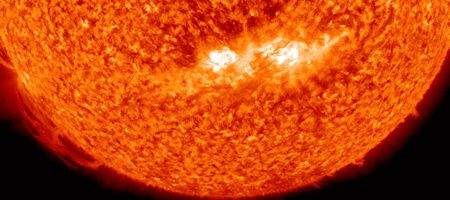Predicting solar flares is going to become increasingly important as the sun hits the most active phase of its 11-year cycle.
Flares can disrupt communication systems, air travel, power grids and satellites, and can also endanger astronauts in space.

Now, Stanford researchers have found a way to use acoustic waves to catch sunspots, the precursors to flares, in the early stages of development. The method gives scientists, for the first time, as much as two days’ warning.
“Many solar physicists tried different ways to predict when sunspots would appear, but with no success,” says Professor Phil Scherrer.
The key is the acoustic waves that are generated inside the sun by the turbulent motion of plasma and gases. Near the surface, small-scale convection cells generate sound waves that travel to the interior of the sun and are refracted back to the surface.
The researchers used data from the Michelson Doppler Imager aboard NASA’s Solar and Heliospheric Observatory satellite, known as SOHO, and its replacement, the Solar Dynamics Observatory satellite, which carries the Helioseismic and Magnetic Imager.
Stathis Ilonidis, a Stanford graduate student in physics, was able to develop a way to reduce the electronic clutter in the data so he could accurately measure the solar sounds.
This allows sunspots to be detected in the early stages of formation, as deep as 65,000 kilometers inside the sun. Between one and two days later, the sunspots appear on the surface.
“We know enough about the structure of the sun that we can predict the travel path and travel time of an acoustic wave as it propagates through the interior of the sun,” says Junwei Zhao, a senior research scientist at Stanford’s Hansen Experimental Physics Lab.
“Travel times get perturbed if there are magnetic fields located along the wave’s travel path.” Those perturbations are what tip the researchers off that a sunspot is forming.
By measuring and comparing millions of pairs of points and the travel times between them, the researchers are able to home in on the anomalies that reveal the growing presence of magnetic flux associated with an incipient sunspot.
Through a series of comparisons, the team found that sunspots that ultimately become large rise up to the surface more quickly than ones that stay small. The larger sunspots are the ones that spawn the biggest disruptions, and for those the warning time is roughly a day. The smaller ones can be found up to two days before they reach the surface.
“Researchers have suspected for a long time that sunspot regions are generated in the deep solar interior, but until now the emergence of these regions through the convection zone to the surface had gone undetected,” says Ilonidis.
“We have now successfully detected them four times and tracked them moving upward at speeds between 1,000 and 2,000 kilometers per hour.”






